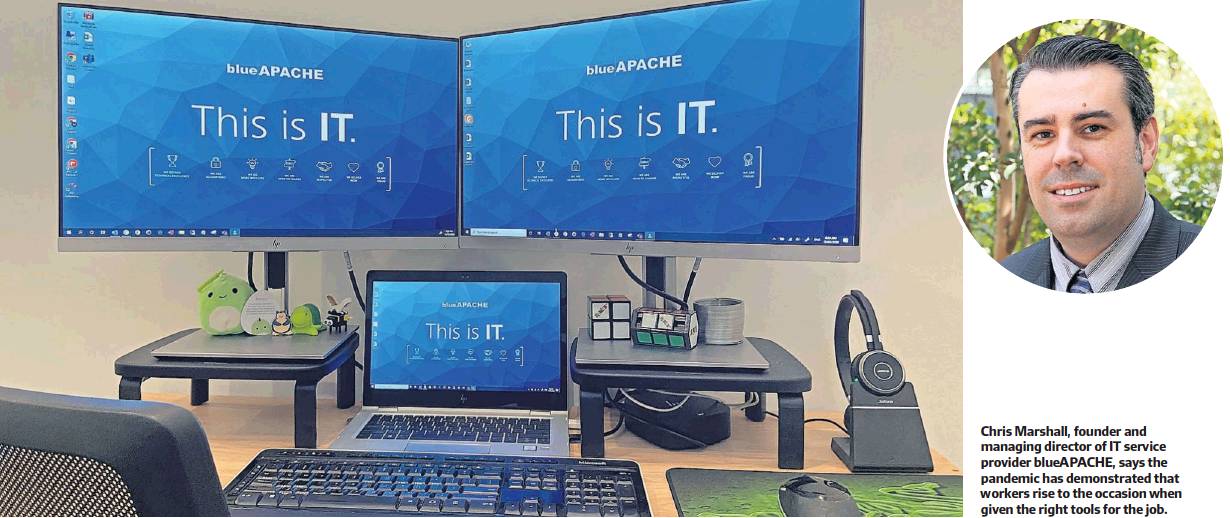‘New normal’ is a faster pace of change
As organisations establish or accelerate their cloud strategy in response to COVID-19, a digital workspace offers a more robust and secure way for staff to work from afar, rather than cobbling together make-shift remote access which can leave a business vulnerable.
Remote working during the pandemic has significantly increased the risk of a successful ransomware attack, according to KPMG. This is due to a combination of weaker controls on home IT networks and a higher likelihood of users clicking on COVID-themed ransomware lure emails.
The need to configure access to various business systems and deploy remote-working capabilities within days, rather than weeks or months, has also seen some organisations inadvertently compromise on security in their rush to respond to the pandemic.
Digital workspaces address these concerns by allowing organisations to quickly and easily equip staff to work from any location using any device, without compromising their security posture. A unified, secure and intelligent digital workspace includes application and desktop virtualisation, secure browsing, access to cloud-based softwareas-a-service (SaaS) apps, single sign-on, file sharing, content collaboration and unified endpoint management.
Building on this, platforms such as blueAPACHE’s emPOWER Intelligent Workspace incorporates guided and automated workflows via machine learning. Built on technology from Citrix, this allows for the automation of routine tasks, personalised insights and prioritisation of top actions to help people work smarter and faster.
The use of MicroApps allows organisations to integrate applications and systems as well as automate common tasks. For example, if some staff only require access to the financials platform in order to approve invoices, this functionality can be easily integrated into existing apps and workflows.
Along with boosting productivity, a digital workspace also improves security by granting an IT team a complete view into network traffic, users, files and endpoints – also leveraging machine learning and artificial intelligence to protect data from hacks, malware and end-user mistakes.
One advantage of embracing the concept of digital workspaces is that it offers an underlying framework for the future delivery of applications and seamless migrations. This allows organisations to easily support working from home regardless of where they are in their cloud migration journey – if necessary, retaining legacy applications as they move towards a cloud native environment.
Even before the impact of COVID-19, organisations were already shifting their focus to be more on their applications and less on how those applications are delivered, says Chris Marshall – founder and managing director of global IT service provider blueAPACHE.
Historically, IT teams have focused on networks, infrastructure, desktop support and other aspects required to ‘‘keep the lights on’’, while applications teams drove innovation to give the organisation a competitive advantage and help it achieve its business objectives.
Now there is a growing realisation, accelerated by the COVID-19 pandemic, that working with a partner makes an organisation more agile and able to cope with new challenges.
‘‘They choose an application and then it’s blueAPACHE’s job to ensure that every user, everywhere, can access the application and have a great experience with it,’’ Marshall says.
‘‘Behind the scenes, those digital workspaces are delivered across our managed services, our server infrastructure and our unified communications platforms – we’re not just aggregating them from third-party providers – which allows us to deliver a better user experience.’’
Once organisations adopt digital workspaces, the interaction between a user and their applications and data is consistent irrespective of their device and location. This is ideal for those organisations that are looking to adopt flexible workplace arrangements, whether staff are working at home, back in the office or in a hybrid environment due to the ongoing impact of the coronavirus.
Historically, many organisations have had two key misconceptions when it comes to digital workspaces, both of which Marshall says have been put to rest in 2020.
First, from a business perspective, many organisations incorrectly assumed that their people couldn’t be as productive and effective when granted access to the tools to work remotely.
‘‘The amazing response to the pandemic has clearly proven this wrong, which will require some organisations to change their attitudes to flexible work arrangements,’’ Marshall says. ‘‘It’s clear that when you give people the right tools for the job, they will rise to the occasion.’’
Second, from a technology perspective, many organisations tend to assume incorrectly that implementing this kind of change is difficult and time consuming.
COVID-19 has not only set a ‘‘new normal’’ when it comes to workplaces, it has also set a new normal in terms of what’s achievable in short timeframes.
‘‘Historically, a project might have had a sixmonth deployment timetable, but we’ve demonstrated that you can deploy a new application and realise value within days or weeks,’’ Marshall says.
‘‘Now we’ve proven it can be done, going forward, organisations are realising that they will be at a competitive disadvantage if they ease off on their pace of business transformation and do not accept it as the new normal.’’
